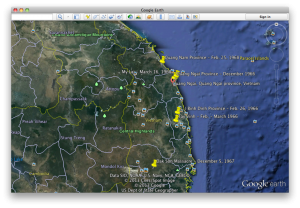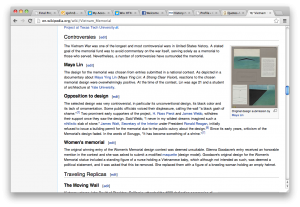On November 13, 1982, America’s most cherished memorial was dedicated and was noted on the official registrar of National Historic Places. Less than four years earlier, the design of the Vietnam Veteran’s Memorial was only a prototype in the head of Maya Lin, a Vietnamese refugee of the war. Her idea ultimately won the national competition that had been established to determine the building of the monument. The Vietnam War had struck close to home in the hearts of Americans, thus, it was only right that an ordinary member of the general populous be able to come up with a design. Four main points had to be followed in order to be eligible as the featured design. The wall had to:
1. be reflective and contemplative in character;
2. harmonize with its surroundings;
3. contain the names of those who had died in the conflict or who were still missing;
4. make no political statement about the war.
(source: http://thewall-usa.com/information.asp)
Lin’s design was the one deemed to fit the criteria most completely. The end result, (for the most part), has been quite positive, and the Veteran’s Memorial remains a favorite in the hearts of many Americans. More than anything, it does not make much of any statement about the war. Visiting the memorial, one is swept up with emotion in the quiet storm of solemn silence. It truly is a humbling experience to stand before the ‘black wall.’ As it was intended, it serves as a steadfast reminder of the 56,000 GIs who died in Vietnam. It is literally a wall of grief. (source:http://peaceaware.com/documents/Sanctions%20Against%20Geneva%20Convention.htm).
This webpage has been modeled in the black and white contrast that the memorial portrays. It serves as a reminder for those who tragically lost their lives in the conflict. However, this webpage’s true purpose is to expose the brutality, injustice and mistakes of the Vietnam War, and the legacy it left behind for future American wars. Unlike the previous wars fought by Americans, the Vietnam War was the first where the number of civilian casualties greatly outweighed that of GI casualties – 340,000 civilian casualties blamable on the US. Furthermore, my data shows that there can be no denying that sense the Vietnam conflict, American wars (and certainly wars fought by many other nations) have increasingly featured more civilian deaths. Additionally, my home page features three real-life incidences of unspeakable abuse done to innocent Vietnamese people by American soldiers with little or no consequence. This is more for effect and to draw the audience in than anything else, but it nevertheless adds value to the page. In war sometimes bad things happen, however, the sheer violence of the Vietnam conflict, coupled with the fact that many people believe we should never have been over there in the first place, leaves the Vietnam War as a huge blight in America’s history.
Just as disturbing as our presence was in Vietnam during the main conflict, so too was our vacancy after it ended. For instance, after dumping 20,000,000 gallons of the chemical Agent Orange over the jungles and cities of Vietnam, for years, the American government denied the effects it was having on the land and its people. Initially, even American vets complaining of complications and defects caused by the toxin were turned away. My project outlines the negative impact done to Vietnam and its people by the implementation of Agent Orange. This attitude towards the use of Agent Orange generally reflects the attitude of the American government toward the entirety of the war: little to zero accountability for their mistakes during the conflict. (source: Pellow, David N. Resisting Global Toxics: Transnational Movements for Environmental Justice, MIT Press, 2007, p. 159).
Ultimately, this webpage serves to produce the truth about the unjust nature of the conflict; the page’s graphic content is necessary in order to illustrate the ‘unnecessary.’ Walking past all those names on the wall at the memorial I can only wonder how much bigger it would be had the design included names of all the innocents who lost their lives. America is a great nation, and we certainly lead the way in terms of democracy and righteousness, but the Vietnam War is a conflict we failed to participate in with a diligent sense of morality.
The overall design and navigational functions of my webpage are rather simple. I made it this way, along with mostly black and white colors to emulate the style of the Vietnam Memorial. Like the memorial, my intention with the page’s structure is to set a solemn mood for the viewer. For this reason also, most of my images are in black and white. I included two videos in my media section that do quite a nice job in relaying the brutality and lasting impact of the Vietnam War (the hip-hop video might be hard to listen to, but it is a real treasure). I don’t plan to maintain my website very much after the class is over, so I am not overly concerned with security threats, however, if it does continue to stay up I will have to go over any copyright issues I may have.
Link to project: http://cjohn9.wix.com/vietnam



